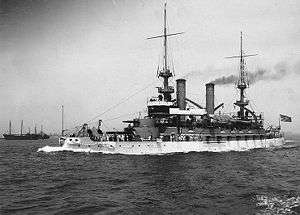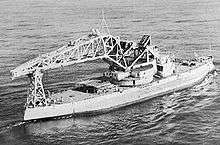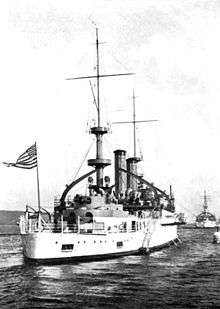Kearsarge-class battleship
 USS Kearsarge – the lead ship of the class | |
| Class overview | |
|---|---|
| Name: | Kearsarge class |
| Builders: | Newport News SB&DD |
| Operators: |
|
| Preceded by: | USS Iowa |
| Succeeded by: | Illinois class |
| Built: | 30 June 1896 – 24 March 1898 |
| In commission: | 20 February 1900 – 18 May 1920 |
| Completed: | 2 |
| Retired: | 2 |
| General characteristics | |
| Type: | Pre-dreadnought battleships |
| Displacement: | 11,540 short tons (10,470 t) |
| Length: | 375 ft 4 in (114.40 m) |
| Beam: | 72 ft 2.5 in (22.009 m) |
| Draft: | 23 ft 6 in (7.16 m) |
| Installed power: | 5 boilers, 10,000 ihp (7,500 kW) (design) |
| Propulsion: | 2 VTE engines, 2 propeller shafts |
| Speed: | 16 kn (18 mph; 30 km/h) (design) |
| Complement: | 38 officers and 548 or 549 enlisted men |
| Armament: |
|
| Armor: | |
The Kearsarge-class battleships were two pre-dreadnought battleships built for the United States Navy at the beginning of the 20th century. They were designed to be used for coastal defense. Both of the ships, USS Kearsarge and USS Kentucky, were authorized in 1895 and commissioned in 1900.[3] Neither ship participated in a major battle, although they participated in the Great White Fleet, the oldest ships on the cruise.[4] Kentucky was decommissioned in 1920 and sold for scrap in 1923. Kearsarge was also decommissioned in 1920, although it was then converted into a crane ship, and served in that capacity until scrapping in 1955.
Design
General characteristics
The Kearsarge-class battleships were designed to be used for coastal defense.[5] They had a displacement of 11,540 short tons (10,470 t), an overall length of 375 feet 4 inches (114.40 m), a beam of 72 feet 2.5 inches (22.009 m)[6] and a draft of 23 feet 6 inches (7.16 m).[7] Like the Indiana class, the Kearsarge class also had a very low freeboard, which resulted in her guns becoming unusable in bad weather.[8] Kearsarge was manned by 38 officers and 548 enlisted men, while Kentucky carried 38 officers and 549 enlisted men.[6]
Armament
.jpg)
The Kearsarge-class battleships had two double turrets, with two 13 in (330 mm)/35 caliber guns and two 8 in (203 mm)/40 caliber guns each, stacked in two levels.[9] The guns and turret armor were designed by the Bureau of Ordnance, while the turret itself was designed by the Bureau of Construction and Repair. This caused the guns to be mounted far back in the turret, making the ports very large. Admiral William Sims claimed that as a result, a shell fired into the port could reach the magazines below, disabling the guns.[10]
In addition to these guns, the battleships carried fourteen 5 in (127 mm)/40 caliber guns, twenty 6-pounder (57 mm or 2.2 in) guns, eight 1-pounder (37 mm or 1.5 in) guns, four .30 in (7.6 mm) machine guns, and four 18 inch (450 mm) torpedo tubes.[6]
Armor
The ship's waterline armor belt was 5–16.5 inches (130–420 mm) thick and the main gun turrets were protected by 15–17 inches (380–430 mm) of armor, while the secondary turrets had 6–11 inches (150–280 mm) of armor. The barbettes were 12.5–15 inches (320–380 mm) thick, while the conning tower had 10 inches (250 mm) of armor.[7] The forward bulkhead was 10 inches (250 mm) thick and the aft bulkhead 12 inches (300 mm) thick.[11] The armor was made of harveyized steel.[6]
Propulsion
The battleships had two 3-cylinder vertical triple-expansion steam engines and five Scotch boilers, connected to two propeller shafts.[6] The ships were designed to produce a total of 10,000 indicated horsepower (7,500 kW) giving 16 knots (30 km/h; 18 mph).[12] During sea trials, the indicated horse power and speed exceeded the design, producing a total of 11,674 indicated horsepower (8,705 kW) giving 16.816 knots (31.143 km/h; 19.352 mph) on Kearsarge, and 12,179 indicated horsepower (9,082 kW) giving 16.897 knots (31.293 km/h; 19.445 mph) on Kentucky.[6]
Ships in class
| Name | Hull | Builder | Laid down | Launched | Commissioned | Fate |
|---|---|---|---|---|---|---|
| USS Kearsarge | BB-5 | Newport News SB&DD | 30 June 1896 | 24 March 1898 | 20 February 1900 | Converted to a crane ship in 1920, sold for scrap on 9 August 1955 |
| USS Kentucky | BB-6 | Newport News SB&DD | 30 June 1896 | 24 March 1898 | 15 May 1900 | Sold for scrap, 24 March 1923 |
USS Kearsarge (BB-5)
Kearsarge was launched on 24 March 1898, and commissioned on 20 February 1900.[3] From 1900–1905, Kearsarge served as flagship of the North Atlantic Squadron, except for a short period in 1903 when she was reassigned as flagship of the European Squadron. In 1905, Maine replaced Kearsarge as flagship of the North Atlantic Fleet, although she remained with the fleet.[13]
In 1907, the Great White Fleet was ordered by U.S. President Theodore Roosevelt to circle the world, as a demonstration of the might of the United States Navy.[14] Kearsarge was attached to the Fourth Division of the Second Squadron.[15] The fleet left from Hampton Roads on 16 December 1907, circled South America, passed through San Francisco, and arrived at Hawaii. From there they sailed to New Zealand and Australia, visited the Philippine Islands, Japan, China, and Ceylon before transiting the Suez Canal. The fleet split at Port Said, with Kearsarge leaving for Malta and Algiers, before reforming with the fleet at Gibraltar. She returned to Hampton Roads on 22 February.[16]

Between 1909 and 1911, Kearsarge was modernized at the Philadelphia Naval Shipyard.[17] She was recommissioned on 23 June 1915,[18] and operated along the Atlantic coast. Until the United States joined World War I, she trained naval militia from Massachusetts and Maine. During the war, she was used to train Armed Guard crews and naval engineers during cruises along the Atlantic seaboard.[13] Kearsarge decommissioned at the Philadelphia Navy Yard on either 10 May[13][19][20] or 18 May 1920.[21][3]
Kearsarge was converted into a crane ship, and was given hull classification symbol IX-16 on 17 July 1920,[22] but it was changed to AB-1 on 5 August.[19] Her turrets, superstructure, and armor were removed, and were replaced by a large revolving crane with a lifting capacity of 250 long tons (250 t), as well as 10-foot (3.0 m) blisters, which improved her stability.[23] The crane ship was used often over the next 20 years, including the raising of USS Squalus in 1939.[20] On 6 November 1941, Kearsarge was renamed Crane Ship No. 1, allowing her name to be given to Hornet (CV-12), and later to Kearsarge (CV-33).[20] She continued her service, however, handling guns, turrets, armor, and other heavy lifts for vessels such as Indiana,[24] Alabama, Savannah, Chicago, and Pennsylvania.[18] She was transferred to the San Francisco Naval Shipyard in 1945, where she participated in the construction of Hornet, Boxer, and the re-construction of Saratoga.[13] In 1948, she left the West Coast for the Boston Naval Shipyard.[25] On 22 June 1955, her name was struck from the Naval Vessel Register, and she was sold for scrap on 9 August.[4]
USS Kentucky (BB-6)

Kentucky was launched on 24 March 1898, and commissioned on 15 May 1900.[3] In 1900, she left for China due to the Boxer Rebellion, staying there until 1904.[26] In 1905, she joined the North Atlantic Squadron.[26] During the 1906 Cuban Insurrection, she carried Marines to Cuba, embarking them from Provincetown, and landing them at Havana, Cuba.[26]
In 1907, Kentucky participated in the Great White Fleet, as part of the Fourth Division of the Second Squadron.[15] The fleet left from Hampton Roads on 16 December 1907, circled South America, passed through San Francisco, and arrived at Hawaii. From there, they sailed to New Zealand and Australia, visited the Philippine Islands, Japan, China, and Ceylon before transiting the Suez Canal. The fleet split at Port Said, with Kentucky visiting Tripoli and Algiers, before reforming with the fleet at Gibraltar. She returned to Hampton Roads on 22 February.[16]
From 1909–11, Kentucky was modernized at the Philadelphia Naval Shipyard.[17] From 1912–15, she served in the reserve, and was recommissioned at Philadelphia on 23 June 1915. Following the United States occupation of Veracruz, she sailed to Mexico, remaining at Veracruz until 1916. She arrived at New York, remaining there until the United States entered World War I. During the war, she trained several thousand men along the Atlantic coast.[26]
In late 1918, Kentucky was overhauled at the Boston Navy Yard. She then left for exercises in Guantanamo Bay, Norfolk, and along the New England coast, and later trained United States Naval Academy midshipmen.[26] Kentucky was decommissioned on 29 March 1920,[3] her name was struck from the Naval Vessel Register on 27 May 1922, and she was sold for scrap to Dravo Corporation on 24 March 1923.[27]
References
- ↑ (2001) Jane's Fighting Ships of World War I, pg. 138. Random House, London. ISBN 1851703780
- ↑ (2001) Jane's Fighting Ships of World War I, pg. 138. Random House, London. ISBN 1851703780
- 1 2 3 4 5 Reilly & Scheina 1980, p. 83.
- 1 2 Albertson 2007, p. 177.
- ↑ Crawford 2008, p. 12.
- 1 2 3 4 5 6 Reilly & Scheina 1980, p. 94.
- 1 2 Chesneau, Koleśnik & Campbell 1979, p. 141.
- ↑ Reilly & Scheina 1980, p. 92.
- ↑ Friedman 1985, p. 30-32.
- ↑ Friedman 1985, p. 17.
- ↑ (2001) Jane's Fighting Ships of World War I, pg. 138. Random House, London. ISBN 1851703780
- ↑ Friedman 1985, p. 427.
- 1 2 3 4 DANFS Kearsarge (BB-5).
- ↑ Albertson 2007, p. 26.
- 1 2 Albertson 2007, p. 46.
- 1 2 Albertson 2007, pp. 181–192.
- 1 2 Friedman 1985, pp. 82–83.
- 1 2 Newhart 1995, p. 21.
- 1 2 Friedman 1985, p. 419.
- 1 2 3 Albertson 2007, p. 179.
- ↑ NVR Crane Ship No. 1 (AB 1).
- ↑ Bauer & Roberts 1991, p. 103.
- ↑ Graff 2010, p. 54.
- ↑ Garzke & Dulin 1995, p. 72.
- ↑ Morris & Kearns 2011, p. 206.
- 1 2 3 4 5 DANFS Kentucky (BB-6).
- ↑ NVR Kentucky (BB 6).
Bibliography
Printed sources
- Albertson, Mark (2007). They'll Have to Follow You!: The Triumph of the Great White Fleet. Tate Publishing & Enterprises. ISBN 978-1-60462-145-7. Retrieved 3 January 2013.
- Bauer, Karl Jack; Roberts, Stephen S. (30 November 1991). Register of Ships of the U.S. Navy, 1775-1990: Major Combatants. Greenwood Publishing Group. p. 103. ISBN 0313262020.
- Chesneau, Roger; Koleśnik, Eugène M.; Campbell, N.J.M. (1979). Conway's All the World's Fighting Ships, 1860–1905. London: Conway Maritime Press. ISBN 0-85177-133-5.
- Crawford, Michael J. (12 May 2008). The World Cruise of the Great White Fleet: Honoring 100 Years of Global Partnerships and Security. United States Government Printing Office. ISBN 978-0-945274-59-9. Retrieved 3 January 2013.
- Friedman, Norman (1985). U.S. Battleships, An Illustrated Design History. Annapolis, Maryland: Naval Institute Press. ISBN 0-87021-715-1. Retrieved 1 January 2013.
- Garzke, William H., Jr.; Dulin, Robert O., Jr. (1995). Battleships: United States Battleships, 1935–1992 (2nd revised and illustrated ed.). Annapolis, Maryland: Naval Institute Press. p. 72. ISBN 1-55750-174-2.
- Graff, Cory; Puget Sound Navy Museum (16 June 2010). The Navy in Puget Sound. Charleston, South Carolina: Arcadia Publishing. p. 54. ISBN 978-0-7385-8081-4.
- Morris, James Matthew; Kearns, Patricia M. (30 March 2011). Historical Dictionary of the United States Navy (2nd ed.). Scarecrow Press. ISBN 0-8108-7229-3. Retrieved 27 January 2013.
- Newhart, Max R. (1995). American Battleships: A Pictorial History of BB-1 to BB-71. Pictorial Histories Publishing Company. ISBN 978-1-57510-004-3. Retrieved 16 January 2013.
- Jane's Fighting Ships of World War I. London: Random House Group, Ltd. 2001. p. 138. ISBN 1-85170-378-0.
- Reilly, John C.; Scheina, Robert L. (1980). American Battleships 1886–1923: Predreadnought Design and Construction. Annapolis, Maryland: Naval Institute Press. ISBN 0-87021-524-8.
Online sources
- "Kearsarge". Dictionary of American Naval Fighting Ships. Navy Department, Naval History and Heritage Command. Retrieved 10 January 2013.
- "Kentucky". Dictionary of American Naval Fighting Ships. Navy Department, Naval History and Heritage Command. Retrieved 2011-10-01.
- "Crane Ship No. 1 (AB 1)". Naval Vessel Register. United States Navy. Retrieved 11 January 2013.
- "USS Kentucky (BB 6)". Naval Vessel Register. United States Navy. Retrieved 6 January 2013.
External links
 Media related to Kearsarge class battleships at Wikimedia Commons
Media related to Kearsarge class battleships at Wikimedia Commons